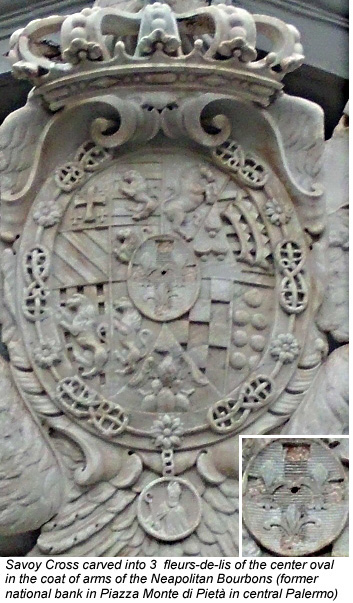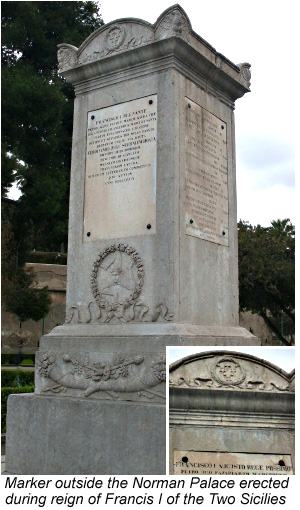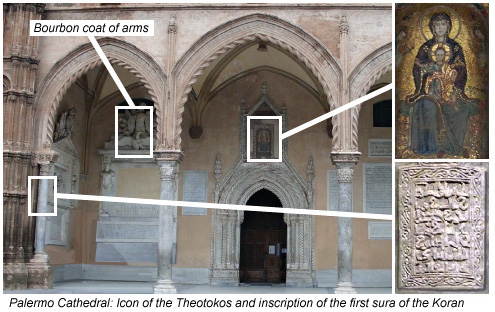...Best of Sicily presents... Best of Sicily Magazine. ... Dedicated to Sicilian art, culture, history, people, places and all things Sicilian. |
by Luigi Mendola | ||
Magazine Index Best of Sicily Arts & Culture Fashion Food & Wine History & Society About Us Travel Faqs Contact Map of Sicily
|
I beseech thee,when you return to the world "History is written by the victors," said Hitler. What he did not say, so far as we know, is that what "official" or "accepted" history omits is at least as significant as what it explicitly states. This is hardly a novel idea. In fact, it forms the foundation of a new book that has received much critical acclaim:Vanished Kingdoms - The History of Half-Forgotten Europe by Norman Davies (Penguin 2011). Sicily's complex history is considered at some length in two chapters, Aragon and Sabaudia (Savoy). Interestingly, the author includes Italy among existing states which look as if they could - in theory - be divided to reflect something of a former existence, a theory well-grounded in Italy's current social and political realities. That would be a drastic "solution" to the country's problems, perhaps no solution at all. But the fact that Aosta, Alto Adige (South Tirol) and Sicily are already semi-autonomous regions, while the separatist Lega Nord party seeks to liberate "Padania" (Lombardy, Piedmont and Venetia) from Italy, renders the idea less bizarre than it might otherwise seem. Advocates of actual secession are already being placated by the promise of federalism. The Kingdom of Sicily lasted 730 years, to be succeeded by a Kingdom of Italy that survived just 85 - not much longer than the ill-fated Soviet Union (the focus of another chapter in Davies' book) or even the lifetime of the average Sicilian. Questions of excessive Italian regionalism, the lack of patriotism, the impact of Fascism and the Second World War on national identity, class warfare, and certainly the grander questions of ethnicity and the meaning of history, lie beyond the scope of this article. But that doesn't mean that they are not relevant to it. Sicily is one of the world's most conquered places, and each subsequent ruler made at least some effort to smash the slate of his predecessors to shards and leave to his successors a new one bearing a more edifying inscription favourable to himself. The Greek rulers of ancient Syracuse come to mind, and so does the word coined to describe them: tyrants. But beginning late in the Middle Ages, in the wake of Sicily's Norman-Arab-Swabian "Golden Age" (already in its death throes by 1260), the Inquisition and a series of "foreign" rulers found it in their best interest to revise history just a little bit more. Indeed, it seemed to worsen as centuries passed, reaching a virtual boiling point by the middle of the nineteenth century with the controversial Italian unification movement or Risorgimento. Let's begin our brief journey in the present, working our way backward. You won't be made to visit archives and libraries; a simple walking tour will suffice, but it's not the "typical" tour offered by guide books and licensed tour guides. The first stop is a historical square in central Palermo, behind the cathedral, a few steps beyond the Punic walls of Via Candelai, down the street from the Romanesque-Gothic church of Saint Augustine. On one side of Piazza Monte di Pietà is a large grey building erected in the eighteenth century. The date (1866) prominently if deceptively displayed on the stout tower actually refers to the year the clock was installed. This was the national bank of the Kingdom of Sicily until 1816, and its regional headquarters from then until 1860 (when Sicily was part of the Kingdom of Naples or the "Two Sicilies"). It still houses a bank - a private one. Above the entrance, carved into white marble, is a simplified interpretation of the coat of arms of the House of Bourbon of the Two Sicilies, descended from the kings of France and Spain. In the escutcheon (small shield) in the centre of this complex design is the traditional coat of arms of the dynasty, three fleurs de lis. Here, however, it is not very distinct. That's because the simple "Cross of Savoy" was carved into it, but not deeply enough to completely obscure the fleurs de lis. Perhaps somebody thought it prudent to avoid completely defacing the fleur de lis, considering the possibility of a Bourbon restoration. (See the photograph and inset.) Incidentally, the figure in the medallion suspended from the chain encircling the entire oval shield is San Gennaro (Saint Januarius), the patron saint of Naples; the chain is the Bourbons' Order of Saint Gennaro, which, like the Constantinian Order, is still bestowed today. Another vestige of the Bourbon era is a marker still standing outside the walls of the Norman Palace across from Piazza Indipendenza. Erected in 1826 during the brief reign of Francesco I, this bears inscriptions indicating the distance of various cities from Palermo. The Bourbons' fleur de lis is visible at the top. The three-legged trinacria, an ancient symbol of Sicily, appears in relief below the inscriptions. This symbol officially "vanished" after 1860 along with most other "regional" ones.
Oddly enough, the Bourbon state was not particularly revisionist, nor were the kindred dynasties of Austria and Spain that ruled Sicily immediately before them. (This briefly included a Savoy, Vittorio Amedeo II, from 1713 to 1720.) On the contrary, each earlier dynasty looked to the past to justify rule in the present; to mimic democracy, the Savoys' ministers held a rigged referendum which saw 99% of voters (property-holding males) confirming the annexation of Sicily following an undeclared war against the Kingdom of the Two Sicilies. It is also worth noting that, contrary to popular perceptions, it was Ferdinando I of the Two Sicilies, not his cousin Carlo Alberto of Savoy, who granted the first "modern" constitution in the pre-unitary Italy, in 1812; an important distinction is that Carlo Alberto's Statuto (of 1848) lasted longer. However, it would be inaccurate to describe any of the various Italian states of the nineteenth century as especially "enlightened" or democratic. Nevertheless, Sicily had witnessed a number of ephemeral parliaments and constitutions over the centuries. There were sophisticated legal codes, such as the Constitutions of Melfi - revolutionary for their time - and even the rudiments of common law. Though none of this approached the significance or permanency of England's Magna Carta, what existed in the various Italian states north of Sicily never even came remotely close to it. By the eighteenth century, it was rarely a question of the monarchs themselves, who for the most part left politics and policy to their politicians, ministers and bureaucrats. Yet history has left us with a perception of some kings being better than others, and for the common man life didn't improve much from one decade to the next. This is one reason why many Italians - and perhaps most Sicilians - viewed the events of 2011 commemorating Italian "unification" with a cynical eye. If Sicily was a police state under the Bourbons, it was no better under the Savoys, whose government ruthlessly suppressed a series of pro-Bourbon revolts between 1861 and 1866, exiling many captured dissenters and partisans - who they called "brigands" - to die in concentration camps in Piedmont in northern Italy. Press censorship, poverty and other factors worsened after 1860, eventually prompting the mass emigration of millions of southern Italians between 1880 and 1920, whereas earlier emigration was from what until then had been the comparatively poor north of Italy - regions that included Piedmont, Lombardy, Venetia and Tuscany (not that Italians in any part of the country were particularly affluent or literate). After 1922, matters worsened under Fascism, a regime many Italians found palatable because in many respects it was little different from what most of them had known for generations. The regime eventually claimed the Savoys themselves among its victims, but one of the worse effects of Fascism and the Second World War was that most older Italians, ashamed to acknowledge the facts or recount these to their children, ensured that very little of Italy's history after 1920 was taught in the schools until about eighty years later. For this reason and others, many younger Italians (under 30) boast a greater knowledge of this history than their parents do. The harsh facts were artfully overlooked during the national festivities marking 150 years of Italian "unification" in 2011, though several regionalist political parties and historical organisations published books and held conferences dedicated to the subject, including (perhaps ironically) a few in public "state" settings such as the University of Palermo's Palazzo Steri. They were not, for the most part, arguing against unification per se, but protesting the longstanding revisionism inherent in the Risorgimento as it is still taught in public schools. Without digressing, one might ask whether the people of a place whose continuous history dates from at least 1,000 BC (BCE) should be forced into accepting any series of "facts" and supposed "truths" concocted during the middle of the nineteenth century, themselves revised beginning in 1946 - for the new Republic sought to obliterate the memory of the Savoys as zealously as the Savoys had sought to cancel any trace of the Bourbons. That effort, too, was doomed to failure; obviously, the millions of tourists and pilgrims who visit Rome each year are more interested in the Colosseum and the Vatican than in anything concerning the kings or presidents of the united Italy. Italy is full of Leftists and pseudo-Marxists, but how many of them know that Karl Marx referred to Giuseppe Garibaldi as "King Vittorio Emanuele's carriage driver" because the general supported what his contemporaries viewed as a socially reactionary state? Helped along by the infamous Inquisition, the Roman Catholic Church exercised its own brand of architectural revisionism in Sicily, but it was more nuanced than what was practiced by the island's Baroque kings. A few of many examples can be seen in the Gothic portico of Palermo Cathedral where, incidentally, some inscriptions commemorating the House of Bourbon were never removed - perhaps because the "Savoyard" authorities of the upstart Kingdom of Italy had no direct control over the ecclesiastical seat of the Primate of Sicily (only in 1929 did they sign the treaties regulating the relationship of the Holy See and the Kingdom of Italy). Here we see a few religious vestiges of the twelfth century and, truth be told, they may be a bit older than that.
That mosque had been built on the site of an earlier structure, a large Byzantine basilica, and it is possible that the mosaic icon of the Theotokos (Mother of God) in the niche above the arched portal was preserved from that church. It is, of course, equally possible that it was created for the reconstructed cathedral during the twelfth century. However, its style - which differs from the icons in Monreale and the Palatine Chapel - argues for an earlier date. This icon is quite similar to one in Taormina. We cannot know precisely why the bishops of Roman Catholic Church (as it became known after the Great Schism of 1054) chose to leave these details in tact, having redesigned the entire interior of the cathedral, but we should rejoice that they did. Other treasures, like the Magione Basilica, were restored to their original glory following centuries of concealment by plaster and stucco, while mikvehs (ritual baths) of the Jews of Siracusa and Palermo have been discovered. History may be written - or just revised - by the victors, but ephemera can sometimes be corrected. In restoring the monuments, we may also restore a bit of the truth while defining an authentic Sicilian identity. Further Reading About the Author: Historian Luigi Mendola has written for various publications, including this one. | |
Top of Page |

 Ond'io ti priego che, quando tu riedi
Ond'io ti priego che, quando tu riedi So how did the marker survive?
Essentially, it was overlooked and forgotten. For some time it was obscured
by buildings constructed before 1900. It was made obsolete with alternate
systems of measurement - and eventually the metric system - introduced in
Sicily by the
So how did the marker survive?
Essentially, it was overlooked and forgotten. For some time it was obscured
by buildings constructed before 1900. It was made obsolete with alternate
systems of measurement - and eventually the metric system - introduced in
Sicily by the  In the column to the left is an inscription,
in Arabic script, of the first sura of the Koran: "God is Allah and
Muhammad is his Prophet." Was this column previously part of the Great
Mosque the Normans found on this site in 1071? It's quite possible.
In the column to the left is an inscription,
in Arabic script, of the first sura of the Koran: "God is Allah and
Muhammad is his Prophet." Was this column previously part of the Great
Mosque the Normans found on this site in 1071? It's quite possible.